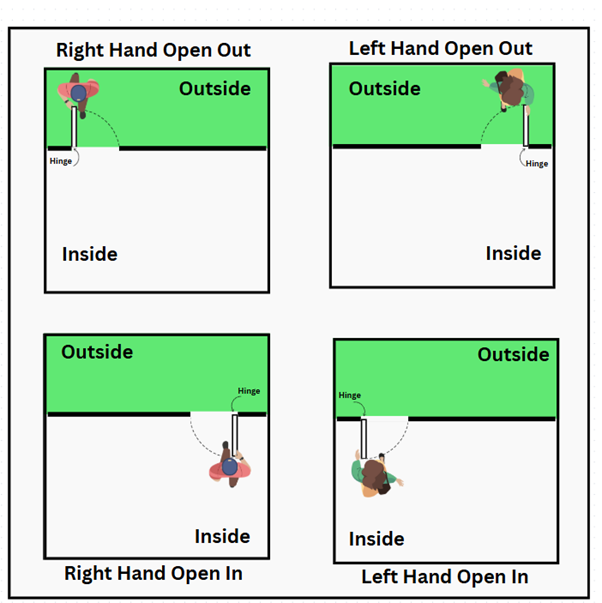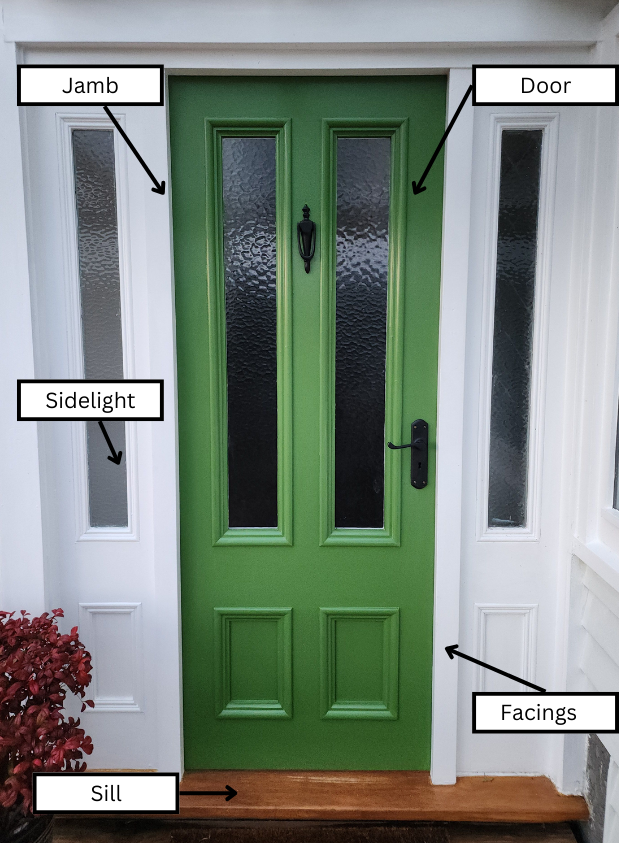Need an exterior door, but unsure of what is required to measure and customise your door? This page shares Hoults Doors expertise with you to help you measure, order, and finish doors.
How do I identify my door’s handing – is it left or right handed?
If you require your door to be hung, you need to tell us your door’s handing.
To tell if your door is left or right hand hung, close the door and stand on the side where the hinge pin is protruding from the door. You can only be on one side of the door frame if you are to see the protruding hinge pin. From here, you can see if the hinge pin is on the left or right side. The side with the hinge pin is the “handing of your door”. When you open the door from this standing point, the door will pull towards you in that direction.


How to identify the parts of an exterior door
For us at Hoults to process your door order, we need to know your chosen door design and your existing door or over frame dimensions – see our How to Measure Guide.
If you require a door sill and facings (refer to diagram), tell us what you need, and your jamb finish size (typically this is a 140mm finish.)
If you are unsure of this information, let us know your chosen door design and dimensions for us to provide an estimate.
How to weatherproof exterior doors with weather seals
Whether you are trying to stop a draft coming into your home, or water from making its way under the door – Hoults has a solution. Hoults Doors offers a range of weather suitable seals for exterior doors.
The two main seals Hoults uses on external applications are the AQ21 Aquamac Seal, and the RP8 Drop seal. These seals together provide both a compression and water resistant effect. This will help keep your home warm and dry.
Door seals offer very specialized solutions. For us to best assist, please contact Hoults for assistance on purchasing the right product.
Painting and Finishing Exterior Doors from Hoults Doors Suppliers
Painting Duramax Doors
Duramax doors, provided by Parkwood Doors, are made of quality composite. You can prime and paint these doors yourself.
Step One – Clean the Door
You need to prepare your exterior door before you paint it by washing it to ensure it is clean and free of residues. You have two options:
- Option One – wash the door thoroughly across all surfaces with sugar soap, and rinse with clean water.
- Option Two: Treat the door with Resene Heavy Duty Paint Prep and Oil Remover, or Dulux House wash, following their instructions.
When you are done ensure all cleaner and residues are washed from the surface using a generous amount of fresh water.
Step Two – Sand the Door
Sanding your door ensures paint or stain will adhere to your door. Don’t skip this step!
Carefully scuff sand all surfaces of your door with 120-240 grit sandpaper. Work carefully to avoid scratching or damaging the door: this may show after finishing the product.
After sanding, dust down the surface of your door until it is dust free. Acetone can be used to assist with this process – however door must be completely dry before painting.
Helpful Tip: Do not use hydrocarbon-based solvents to clean the surface as these may leave a residue.
Step Three: Prime and Paint Your Door
After your door is clean and dust free, lay it down horizontally to paint it. Our professionals often use two sawhorses to support a door during priming and painting. Do not paint a door propped up or mounted in the door frame: you will get drips.
Recommended primer for Duramax doors
Recommended priming products are Dulux Precision Maximum Strength Adhesion Primer, Resene Quick Dry Primer Undercoat, or PPG Paints 3 in 1 Prep. Ensure your primer lists “fiberglass” as a suitable surface.
Recommended topcoats for Duramax doors
Recommended Paints are:
- Light colours – Resene Lustacryl Semi-Gloss Waterborne enamel
- Dark colours – Resene Lustacryl Cool Colour Semi-Gloss Waterborne enamel OR PPG Water Based Enamel.
Apply two top coats of applicable solvent based or acrylic enamel designed for exterior exposure. Sand lightly between coats. Make sure you paint all four edges, and two faces.
Helpful Tip: If you are in a coastal area, a third coat is recommended to mitigate the harsher conditions.
Painting or Staining Timber Doors
You can paint or stain timber doors yourself. Follow our instructions carefully.
Step One – Prepare the Timber Door
Ensure the door is clean and dust free, lightly sand if necessary.
Step Two – Prime the Timber Door
After your timber door is clean and dust free, lay it down horizontally to prime and paint or stain it it. Our professionals often use two sawhorses to support a door during priming and painting. Do not paint a door propped up or mounted in the door frame: you will get drips.
Prime the door with an oil-based primer to prevent compounds from the wood seeping through into the paint, allow to dry. We recommend Resene Wood Primer. Apply two coats, especially for dark timber and timber with high amounts of tannins/compounds.
Step Three – Painting a Timber Door
It is recommended that at least two coats of exterior grade paint are applied to your door. A satin or semi-gloss finish on your door is recommended. Always follow the instructions provided by the manufacturer of the paint. Let each coat of paint on the door dry completely before you add another coat.
Step Three – Staining a Timber Door
For your base coat, our recommendation is Sikkens HLS stain. For your top coat, apply two coats of Sikkens Filter 7.
